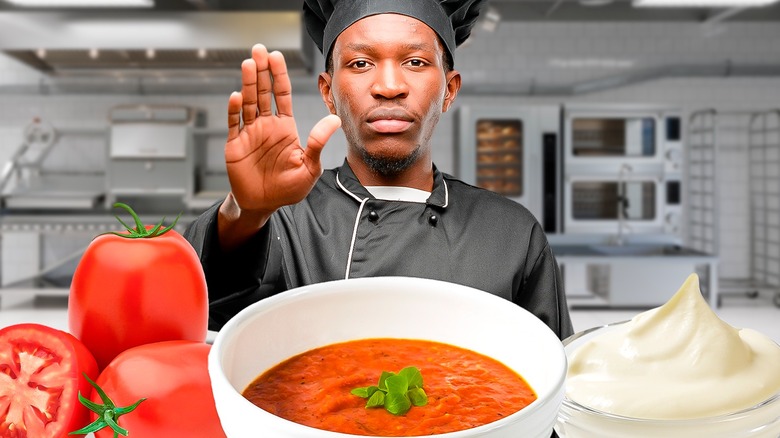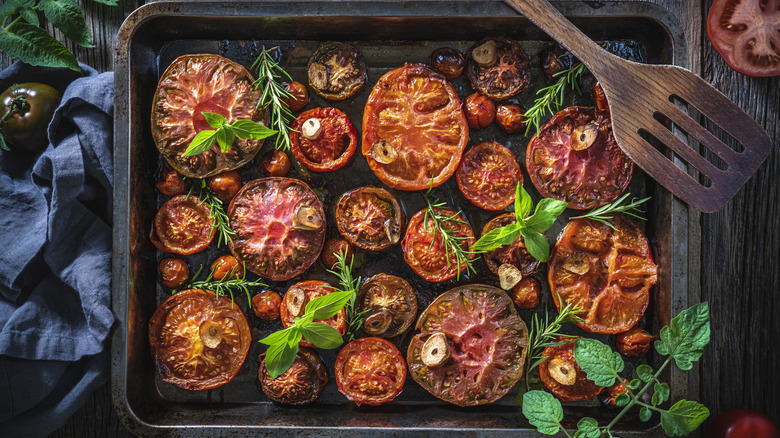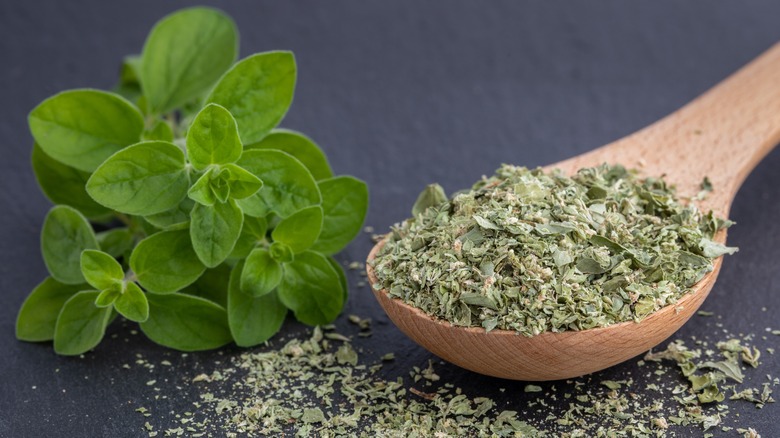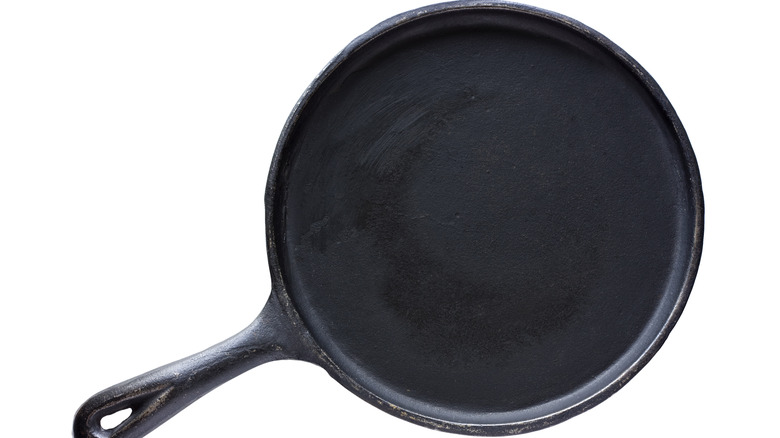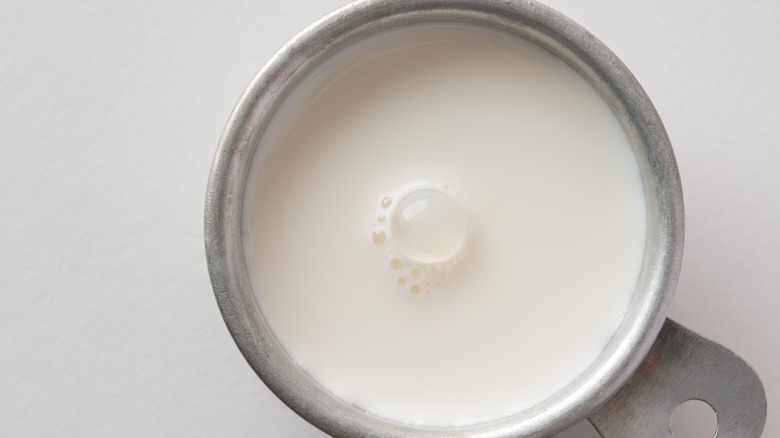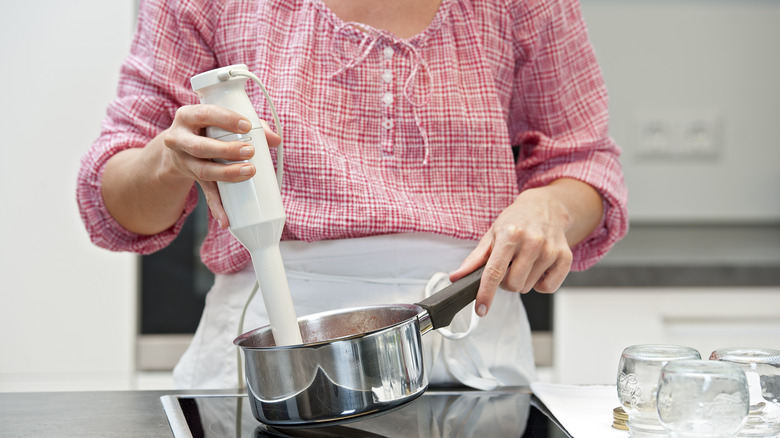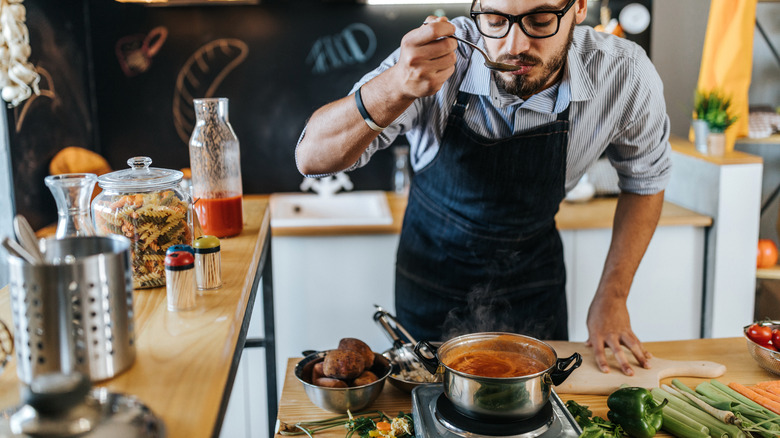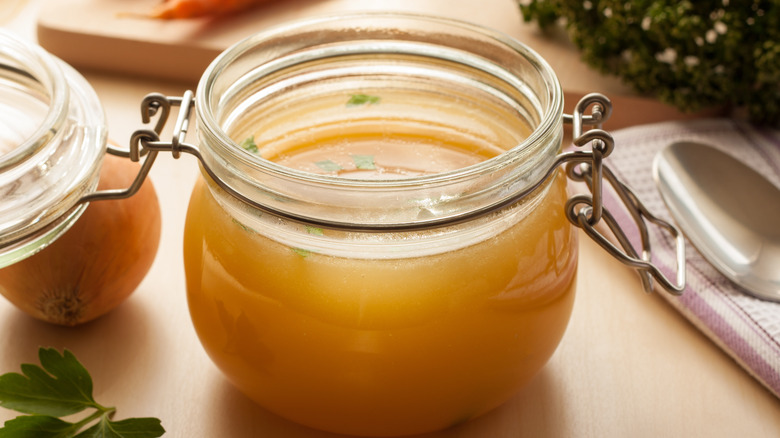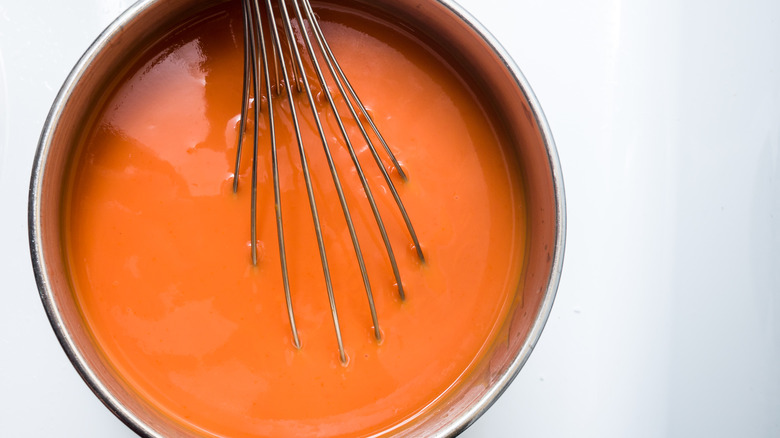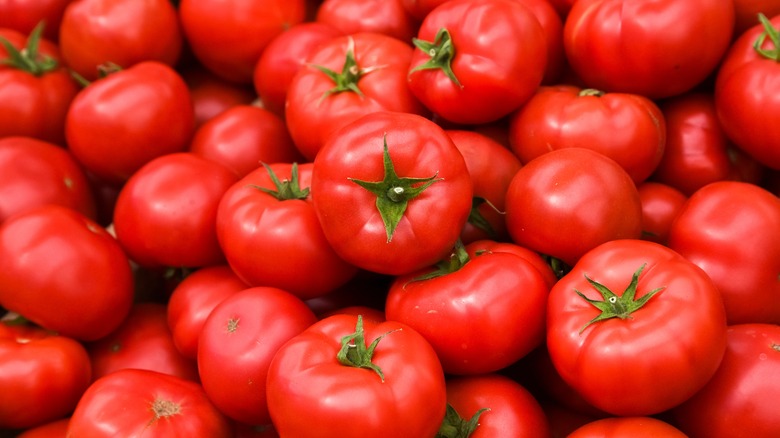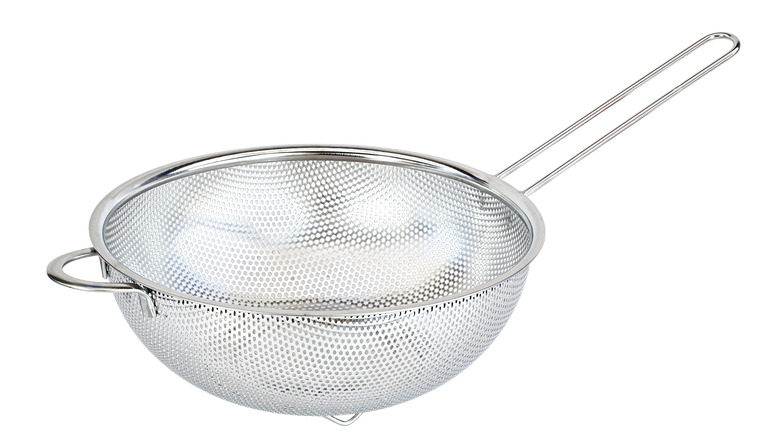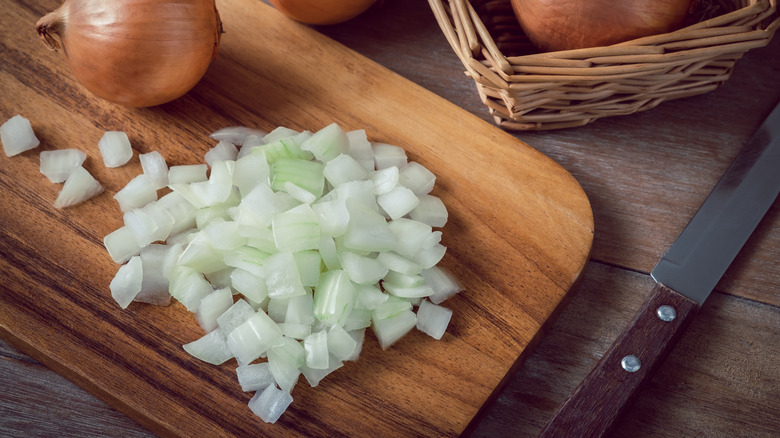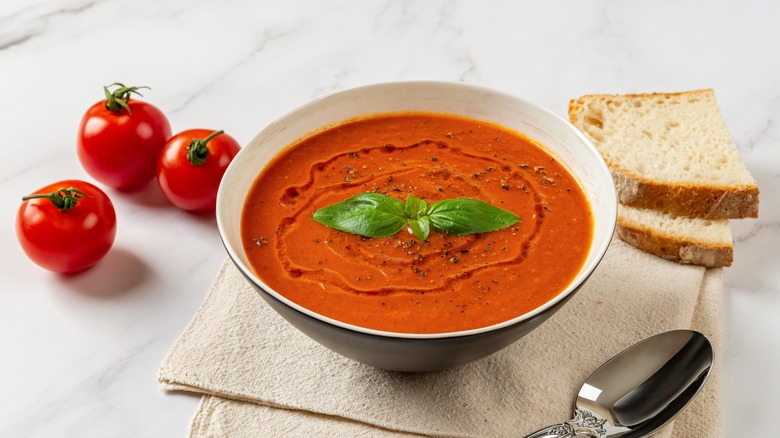13 Mistakes Everyone Makes With Tomato Soup
Tomato soup, a classic comfort dish, seems deceptively simple to prepare, yet many fall prey to common mistakes that can turn this culinary delight into a disappointing experience. Among the most prevalent errors are the choice of ingredients or cookware, or the skipping or misuse of certain techniques. Another stumbling block is the disregard for proper seasoning, whether it be the addition of aromatic herbs or the simple processing of including salt and pepper. A lack of seasoning is the quickest route to a lack of flavor.
Navigating these and other pitfalls is crucial to achieving the perfect bowl of soup. It's one thing to know how to follow a good, basic recipe, incorporating our favorite tips for homemade tomato soup. It's quite another to know what to avoid like the plague — steps taken or avoided that could torpedo your dinner. This is especially true if you're looking to elevate your soup or experiment with new ingredients. Before you go there, it's best to get a handle on what could go wrong. Here's what we think you should focus on.
Not roasting the tomatoes first
The caramelization that occurs when you roast tomatoes in the oven is an essential component of any tomato soup. This is why most tomato soup recipes you find will either require the tomatoes to be roasted before they're added to the soup, or they will ask you to pick up a can of fire-roasted tomatoes from the grocery store.
For instance, while Ina Garten does use canned tomatoes in her tomato soup, she also involves some fresh ones, which she halves and roasts with some olive oil and salt to intensify the flavor of the ingredient. Meanwhile, the sugars that are formed in the cooking process help add a touch of smokiness to the soup along with more depth of flavor than un-roasted tomatoes can accomplish alone. For similar reasons, Bobby Flay also roasts his tomatoes before turning them into soup. In fact, it's one of the very first things he does when he starts on the recipe. This step can be especially helpful if you're cooking with tomatoes in the winter, meaning out of season. The roasting can concentrate the flavor of the tomatoes, hiding the fact that off-season tomatoes can be a bit plain.
Adding conflicting ingredients
If you want to play around with the spices and flavoring of your tomato soup, go ahead. This is such a simple dish at its core that it's practically a blank canvas. Just beware of adding conflicting flavors — nutmeg and dill each taste great on their own or with other spices, but together, usually not.
So before you start playing mad scientist with your canned or homemade tomato soup, decide on a flavor profile you want to follow and stick with it until the end. An example of a great herb combination is something with which tomatoes are quite familiar: a typical pizza spice blend. For this, you can add oregano, dried basil, or the all-encompassing Italian seasoning. Your soup will come out tasting like a good, fresh pizza, minus the cheese. Another option is to go the Southwestern route and add the likes of chili powder, cumin, and paprika. Whichever theme you go for, make sure your spices and herbs are complementary before you put them in the soup. You can always add something later, but you can never take it away.
Using reactive cookware
Tomatoes are a sour bunch. They might not taste it, but chemically speaking, they're quite acidic, which causes certain reactions in the other ingredients you use with the fruit, not to mention the metal cookware you employ. In fact, the key thing to know about cooking tomatoes, whether it's for soup, sauce, or any other reason, is that they should steer clear of reactive cookware and stick with the non-reactive kind.
If you've never heard of this distinction before, don't worry, it's quite simple. Reactive cookware, such as our beloved cast iron skillets, is free of enamel or other protective coatings, leading some of the metals contained within to leech into the food. Tomatoes, being especially acidic, tend to draw out those metals more than other types of ingredients. As such, it is recommended to cook tomatoes with non-reactive cookware, such as stainless steel pans. So when you roast those tomatoes in the oven before putting them in your soup, make sure you're placing them on top of a non-reactive substance, or your food may end up tasting slightly metallic.
Not reducing the cream beforehand
A great way to add texture and richness to tomato soup is to pour in some cream. But if you think that means just taking a carton of cream out of the fridge and just pouring it into your pot, think again. The best thing to do here is to reduce the cream first before it gets anywhere near your delicious bubbling tomato soup.
This tip comes straight from Bobby Flay, who gently simmers some cream in a pan before including it in the pot. This is because a reduced cream will be thicker and less watery, the moisture has mostly evaporated. In turn, this gives the soup a creamier texture without overcooking the soup itself. Of course, tomato soup can be just as good on its own, without dairy, but if you're going to add cream to the mix, you may as well do it right.
Undercooking the tomatoes before blending them
Tomato soup typically requires some degree of blending, usually with a food processor or immersion blender. This means the ingredients need to be nice and soft before you take a blade to them, or they might end up chopped up into gruel rather than turned into smooth, liquidy soup.
In order to guard against this unsavory fate, it's best to make sure those ingredients are fully cooked. You can do this by using your wooden spoon to press down on them and check for doneness. If they're not soft enough, let them cook a little longer before adding the liquid. Once you're confident they're ready, whip out your immersion blender and get to work. You'll notice right away if you were wrong — your ingredients will likely get lodged in the blade. If you're clear to go, you still have to pay attention: make sure you get every lump of vegetable that might be hidden in the watery depths of your pot, or you'll end up with a chunky gruel, which is not really the point with tomato soup.
Not tasting the soup as you cook
Many cooks, amateur and professional alike, keep a tasting spoon by their stove to help them sample their food as it cooks. This is not a snacking device, or at least, not just a snacking device. It helps the chef determine whether there is too much or too little seasoning at every stage of the cooking process.
You might think this isn't necessary with a recipe as simple as tomato soup or with one you know well and have made hundreds of times. But each time you cook something, you're using a new ingredient: Each individual tomato, for instance, has a slightly different flavor and texture than the next. Even more to the point, each brand of canned tomato may contain different amounts of salt or other spices. As such, you would need to adjust the amount of salt you add to the pot each time to account for these variations. Even so, there's a time and a place for this practice. In fact, it's recommended that you conduct your taste test at least 15 minutes after adding your spices, as these tend to take their time releasing their flavor into the mix. If you taste something immediately after adding a spice, you might not get the full effect, leading to over-salting.
Using poor quality stock
Even though it's called tomato soup, this dish is primarily made up of broth, which makes this one of the most important ingredients on the list. As such, we recommend using good quality stock when you make any soup, especially tomato soup. Store-bought broth, for instance, and especially those handy little bullion cubes, are highly processed and don't taste as good as the homemade version.
Your best bet, then, is really to make your own chicken stock from scratch. That doesn't mean you have to make it anew each time you're in the mood for soup. The good news about this recipe is that you can make a large batch and freeze it in ice trays, for maximum convenience. And it's not even hard to make. Just get your hands on a chicken carcass, which you might already have from that Sunday roast you made, and simmer it with salt and aromatics. This way you can ensure top marks in flavor in addition to controlling the authenticity of the ingredients.
Keeping up the heat
Soup may be hard to burn, what with all that liquid in the pot, but it's not impossible, especially if heavier ingredients get stuck on the bottom and start to blacken. Not only that, but soup is more delicate than it looks. Cooking it on high heat for a long time — boiling it, in essence — can overcook the ingredients, reduce the liquid too much, and zap away all those healthy nutrients you're trying to get by eating soup in the first place.
The solution is to simmer it, slow and steady. Although you may need a moment of high heat at the beginning of the recipe to get things going, as soon as you add your liquid it's time to lower the heat and simmer away for as long as you need. Really, do take your time, because the longer the cooking time, the more time the ingredients will have to bind to each other and blend their flavors together — without burning.
Choosing the wrong tomatoes
When you're making soup, you'll be better served if you choose ripe tomatoes for the job. To do this, use as many senses as you can. First, look at the color to determine how deeply red it is — if it looks yellow or discolored, it's probably not ripe (unless it's a yellow tomato). Second, smell the specimen to see if it emanates a fragrant and sweet odor, which is what you're looking for. Lastly, feel the tomato for soft spots or blemishes, which might indicate rot. Equally, a tomato that is too light and firm might not be ripe yet. The end of summer might be the best time to test out these techniques, as that is prime time for fresh tomatoes.
In winter, however, it's worth switching to canned tomatoes, as good quality fresh ones might be hard to come by. In this case, we recommend opting for canned San Marzano tomatoes for tomato soup, which are renowned for their sweeter taste compared to other varieties. Plus, if you get the real stuff, which comes with a Protected Designation of Origin (POD), you can be confident you're dealing with a good quality ingredient.
Forgetting to strain
Minestrone, clam chowder, and other soups of that ilk are designed to be chunky. Tomato soup, on the other hand, is expected to be smooth and sometimes creamy. But this doesn't just happen as if by magic. There's a whole process that goes into achieving this effect, the first of which is the immersion blender, which goes into your soup once your ingredients are cooked and soft.
And many home cooks will stop there. There's nothing wrong with this — a good blender will take care of most of the large chunks, leaving behind mostly mush. But if you want to elevate your tomato soup by focusing on texture, you might also want to strain it before you serve it. This step takes place after the blending is complete, and to carry it out, you'll need a fine mesh sieve. One that will sit comfortably on top of your pot, without you having to hold it, will make your job easier. Then all you have to do is pour your soup over the sieve, which will catch most of the chunks you're looking to part with, leaving your soup as smooth as can be.
Skipping the aromatics
Aromatics, which typically include sautéed garlic and onion, and maybe chopped carrots and celery, are a base for more soups that you can count on all of your fingers and toes. Indeed, the key to starting a soup recipe on the right foot is to sauté those ingredients with a bit of fat — typically olive oil or butter — which will help caramelize the vegetables and start building that first layer of flavor.
The basic steps are simple: Heat your pan, add your oil or butter, and, once everything is piping hot, throw in the aromatics of your choice. Just make sure the fat is neutral in flavor, or you might end up overpowering the rest of your ingredients. Cook the onions until they become translucent, and only then add your garlic. Garlic tends to burn more quickly than onions and the other usual aromatics, which is why it's important to remember to throw it in towards the end of this step.
Choosing the wrong pairing
Once your tomato soup is ready, it's time to sit back and enjoy it. But chances are, you're not going to only need tomato soup for your meal unless you're not feeling particularly hungry. It is great and all, but it's not the most filling of dishes. As such, it's always a good idea to pair the tomato soup with something that will take care of that side of things.
But you shouldn't settle for just anything. Keep your standards high and pick the right pairing, and for that, we recommend the classic grilled cheese. This simple sandwich is commonly served with tomato soup, which in turn makes a great dipping liquid for your bread. A nice cheddar or Gruyère from your sandwich will cut nicely through the lingering acidity in your tomato soup. For something a bit lighter, this soup also goes well with shrimp. It's no accident that a shrimp cocktail comes with a tomato-based sauce. Your tomato soup will fulfill that role perfectly.
Avoiding the garnish
As tasty as a bowl of tomato soup can be, if there's no garnish or any visible additions to the top of the dish, it might not seem all that enticing. Even just a simple swirl of fine extra virgin olive oil on the top of the plated soup can work wonders. But since we've just established that garnishes can help improve the look of your soup, why not take it a step further and explore your best options?
For tomato soup, big crusty croutons are pleasing to the eye and can provide some nice texture as they sink into the liquid and soften a bit. Add some grated cheese on top, allowing it to melt slightly over the soup and the croutons, and you're turning a plain tomato soup into something almost decadent. But if the tang is what you're looking for, a dollop of crème fraîche on top of your soup might be just the ticket, especially when combined with a scattering of chopped chives for color. And if you're planning on adding that little drizzle of olive oil that goes a long way, do so at the end, so it can encompass all the garnishes involved.
